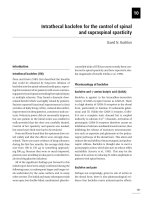Lecture Math for the pharmacy technician: Concepts and calculations: Chapter 4 – Lynn M. Egler, Kathryn A. Booth
Bạn đang xem bản rút gọn của tài liệu. Xem và tải ngay bản đầy đủ của tài liệu tại đây (3.36 MB, 66 trang )
Math for the Pharmacy Technician:
Concepts and Calculations
Egler • Booth
Chapter 4: Drug Orders
McGrawHill
©2010 by the McGrawHill Companies, Inc All Rights Reserved
42
Drug Orders
McGrawHill
©2010 by the McGrawHill Companies, Inc All Rights Reserved
43
Learning Objectives
When you have successfully completed Chapter 4, you will have
mastered skills to be able to:
Summarize the Rights of Medication
Administration.
Interpret a written drug order.
Identify on the information on a
medication order needed to dispense
medications.
McGrawHill
©2010 by the McGrawHill Companies, Inc All Rights Reserved
44
Learning Objectives (con’t)
Locate on medication administration
records or medication cards the
information needed to administer
medication.
Recognize incomplete drug orders.
Select appropriate action for confusing,
incomplete, or illegible drug orders.
McGrawHill
©2010 by the McGrawHill Companies, Inc All Rights Reserved
45
Learning Objectives (con’t)
Identify and verify DEA numbers.
Recognize classifications of controlled
substances.
Recognize prescription errors and forged or
altered prescriptions.
Interpret and use pharmaceutical and
medical abbreviations and terminology.
McGrawHill
©2010 by the McGrawHill Companies, Inc All Rights Reserved
46
Introduction
In order to correctly calculate a
medication dose, you must be able to
read and understand the drug order.
This chapter will discuss:
Drug orders
Patient’s rights
Medication administration systems
Your responsibilities
McGrawHill
©2010 by the McGrawHill Companies, Inc All Rights Reserved
The Rights of Medication
Administration
47
1. Right patient
2. Right drug
To prevent
3. Right dose
errors, check
4. Right route
the rights!
5. Right time
6. Right technique
7. Right documentation
McGrawHill
©2010 by the McGrawHill Companies, Inc All Rights Reserved
48
Right Patient
You are responsible if an error occurs.
Name on original order must be exactly the same
as the name on the Medication Administration
Record (MAR), medication card, or prescription.
Verify the full name.
Ask “What is your name?”
Check the bed number and tag.
Read the patient’s identification bracelet.
McGrawHill
©2010 by the McGrawHill Companies, Inc All Rights Reserved
49
Right Drug
Only give drugs that you have prepared
yourself.
Or that are clearly and completely labeled.
Check the expiration date.
If the patient questions a medication, then
recheck it.
A patient always has the right to refuse a
medication.
Dispose of medicine according to facility
guidelines.
McGrawHill
©2010 by the McGrawHill Companies, Inc All Rights Reserved
410
Right Drug (con’t)
Always check medication
three times:
1. when you take it off the shelf.
2. when you prepare it.
3.
when you replace it on the shelf.
Check it three times even if it is
prepackaged, labeled, and ready
to be administered.
McGrawHill
©2010 by the McGrawHill Companies, Inc All Rights Reserved
411
Right Dose
Later you will learn how to convert from the
dosages ordered by the doctor to the
desired dose.
Use extreme caution when calculating
dosages.
Pay special attention to decimal points.
McGrawHill
©2010 by the McGrawHill Companies, Inc All Rights Reserved
412
Right Route
A drug intended for one route is often not safe
if administered via another route.
Some medications are produced in different
versions for different routes.
For example: suppositories, oral tablets, or
injections
Be especially careful between ophthalmic and
otic routes.
McGrawHill
©2010 by the McGrawHill Companies, Inc All Rights Reserved
413
Right Time
Some medications must be given at a
specific time.
Some medications are given before or
after food, depending on fooddrug
interactions.
Other medicines can be spaced over
waking hours.
McGrawHill
©2010 by the McGrawHill Companies, Inc All Rights Reserved
414
Right Technique
Medications must be given correctly according
to the order. For example:
Buccal between cheek and gum
Sublingual under the tongue
If unsure, check references materials.
Examples:
Physicians’ Desk Reference (PDR)
Facts and Comparisons
Remington: The Science and Practice of Pharmacy
McGrawHill
©2010 by the McGrawHill Companies, Inc All Rights Reserved
415
Right Documentation
Be sure that the right documentation is
completed.
For example, inpatient facilities administer
medication to the patient.
The health professional who administered the
medication must, immediately after the patient
takes the medication, sign the medication
administration record (MAR)
McGrawHill
©2010 by the McGrawHill Companies, Inc All Rights Reserved
Physician’s Orders and
Prescriptions
416
Abbreviations used when writing orders:
general abbreviations
form of medication
route
frequency
You will be expected to have these memorized.
See the next slides for a review of Table 42
McGrawHill
©2010 by the McGrawHill Companies, Inc All Rights Reserved
417
Table 42 Abbreviations Commonly Used
in Drug Orders
McGrawHill
©2010 by the McGrawHill Companies, Inc All Rights Reserved
418
Table 42 Abbreviations Commonly Used
in Drug Orders (con’t)
McGrawHill
©2010 by the McGrawHill Companies, Inc All Rights Reserved
419
Table 42 Abbreviations Commonly Used
in Drug Orders (con’t)
McGrawHill
©2010 by the McGrawHill Companies, Inc All Rights Reserved
420
Table 42 Abbreviations Commonly Used
in Drug Orders (con’t)
McGrawHill
©2010 by the McGrawHill Companies, Inc All Rights Reserved
421
Abbreviations
Joint Commission on Accreditation of Healthcare
Organization (JCAHO) has established a list of
“Do Not Use” and “Undesirable” abbreviations.
See Tables 43 and 44 on the following slides.
Be certain to check abbreviations carefully when
reading drug orders.
McGrawHill
©2010 by the McGrawHill Companies, Inc All Rights Reserved
422
Table 43 “Do Not Use” Abbreviations
McGrawHill
©2010 by the McGrawHill Companies, Inc All Rights Reserved
423
Table 44 “Undesirable” Abbreviations
McGrawHill
©2010 by the McGrawHill Companies, Inc All Rights Reserved
424
Table 44 “Undesirable” Abbreviations (con’t)
McGrawHill
©2010 by the McGrawHill Companies, Inc All Rights Reserved
425
General Abbreviations
a, a
before
BP
blood pressure
c, c
with
NKA
no known allergies
NPO
p, p
s
McGrawHill
nothing by mouth
after
without
©2010 by the McGrawHill Companies, Inc All Rights Reserved









